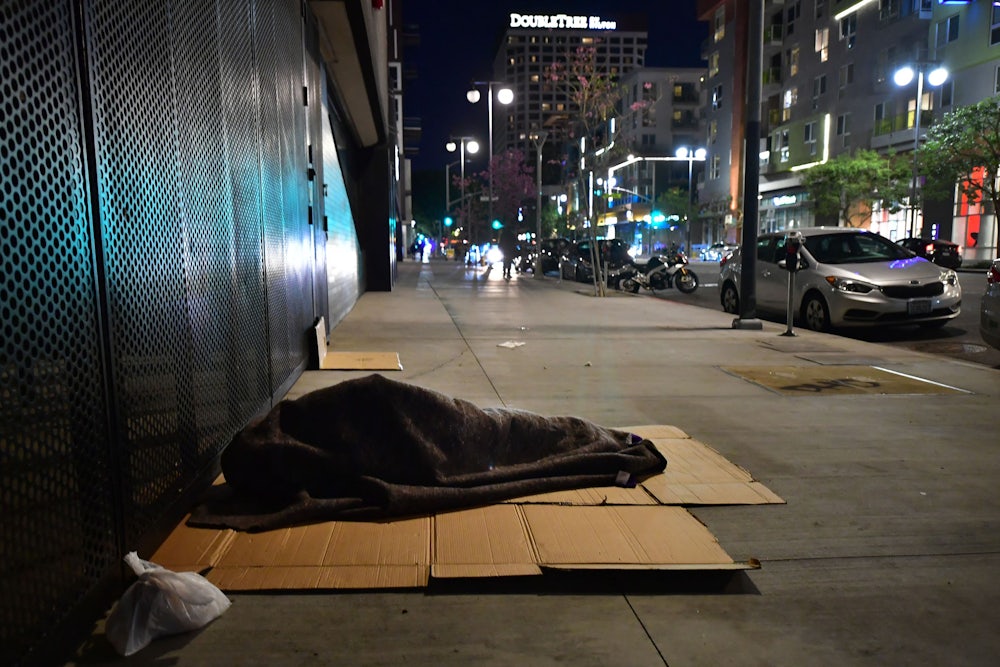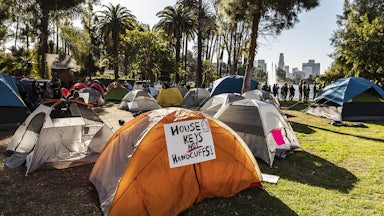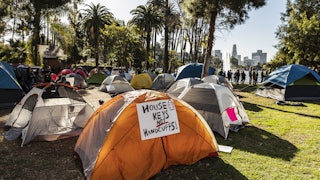Last week, the city of Los Angeles released the results of its 2022 count of the homeless population. It’s the first such count since January 2020; the first conducted since the pandemic started. To no one’s surprise, this census, which was conducted in February, reveals that the unhoused population has gone up: There’s been a countywide increase, from 66,436 in 2020 to 69,144 now. In the City of Los Angeles, the increase was 1.7 percent (41,980, up from 41,290 two years earlier).
The numbers will be used by service providers to figure out what and where services are needed, by policymakers who will allocate funds. According to officials at the Los Angeles Homeless Service Authority, or LAHSA, the data are also showing how investments in social safety nets and housing protections can cut the growth of homelessness considerably—even as Los Angeles struggles to add more affordable housing units. While the homeless population did increase during the pandemic, the rate of the increase has slowed considerably: Prior to the pandemic, homelessness in both counts had grown by double digits for two straight years. Service providers credit a slew of new interventions and a rush of federal and state funding designed to help people either obtain housing or avoid losing their homes.
But this is a particularly fraught moment in the city’s recent history, as homelessness has become the top issue in the pitched mayoral race between Congresswoman Karen Bass and billionaire Rick Caruso, who are advocating, respectively, for essentially more of the same current policy and a greater criminalization of homelessness. The status quo isn’t exactly lacking in cruelty. The city has increasingly criminalized homelessness, and the Los Angeles Police Department and the L.A. Sheriff’s Department have been hard at work violently clearing encampments and interrupting outreach from service providers. With the programs credited for slowing the growth of the homeless population set to expire, service providers are concerned that these hard-won gains might be soon reversed.
While the local government is striving to house people, the problem is more than the system can handle. LAHSA reports that 227 people become unhoused every day, while the county can only house 207 at any given time. But according to Molly Rysman, acting co-executive director of LAHSA, the policies that were implemented during the pandemic work.
“Tenant protections like eviction moratoria and rental assistance implemented by the County and City of LA helped people stay in their homes and not fall into homelessness,” Rysman said at the briefing on Thursday. Kristina Dixon, LAHSA’s other acting co-executive director, added that those programs were critical to the “flattening of the curve” in homelessness growth. The question now is what will happen when these programs expire.
Among Los Angeles’s unhoused population, which includes people in congregate shelters, in encampments on the streets, and living in cars, are some of the most vulnerable people in the county. When the pandemic broke out in 2020, they were also at greater risk, with many either stuck in congregate spaces where Covid-19 can easily spread or lacking shelter altogether. State and local officials acknowledged the danger the pandemic posed to those living on the streets and promised extensive services and support to expand shelters and local services. Unfortunately, the rollout was flawed, and many measures wound down before they ever hit their targets. As a result, this severely limited the impact of several promising interventions.
The city launched a public health effort to try and keep unhoused people safe, opening up new shelters, working with LAHSA and volunteer groups to distribute masks, and setting up handwashing stations around the city. But as LATACO reported, those stations almost immediately hit snags as they went unserviced and quickly ran out of water and soap. Despite claims from City Hall that these matters would be swiftly addressed, the problems persisted, and the program ended last summer, in the midst of a countywide Covid surge.
The state government launched a program called Project Roomkey, which would essentially rent vacant hotel and motel rooms to safely house people in individual spaces and remove them from congregate spaces. But while the announced plan in Los Angeles was to contract and use 15,000 hotel and motel rooms, only around 4,500 were ever leased, despite political pressure from homeless advocates. This program also wound down last year, despite the Covid surges in the summer. Over the course of more than a year, Project Roomkey was able to shelter roughly 10,000 people, fewer than half of whom went on to permanent housing.
Through it all, however, there was one silver lining: No widespread outbreak of Covid hit unhoused communities. And renters also received some protections in the form of an eviction moratorium and a rental assistance program, though that only reached a limited number of people.
Still, as faulty as the rollouts were, advocates said these programs were more effective than nothing at all and were crucial in preventing a massive spike in new unhoused Angelenos. For those already on the streets, some issues persisted. The number of chronically unhoused people—those on the streets for 12 months—grew, by 10 percent countywide and 15 percent in the city. And homelessness is still dangerous: Between April 2020 and March 2021, 1,988 unhoused people in the county died, with drug overdose as the leading cause cause of death.
But the number of sheltered Angelenos also increased by 12 percent countywide and 8.7 percent in the city. That’s in part due to programs such as Project Roomkey and the proliferation of new tiny home villages, Dixon and Rysman said.
Nevertheless, it’s beginning to look like Los Angeles won’t capitalize on these gains, as these programs are already winding down instead of being bolstered and expanded. Currently, there are only four hotels, housing approximately 800 people, operating under Project Roomkey. Three of these receiving funding from the city will cease operations between October and January.
When those protections and programs end, it could cause a “tsunami” of new unhoused people, according to Pete White, executive director of the nonprofit Los Angeles Community Action Network, or LACAN, which provides services and advocacy on Skid Row and throughout the city.
“We operate a legal clinic, and folks are $15,000, $16,000 in arrears for rent. Folks haven’t paid rents because of the protections, and once those are up, you’re either going to have to pay or be houseless,” White said. “If you were one of the lucky few who got rental assistance, that’s good, but not everyone was. We’re about to see the homelessness crisis balloon in 2023.”
It’s already a wretched time for the homeless in Los Angeles, who have faced a growing political backlash: Accusations of unhoused people committing violent crimes and complaints about visible encampments around the city have become ever-present, leading to increased criminalization and sweeps against unhoused people. This summer, the Los Angeles City Council and Mayor Eric Garcetti approved an expansion of city ordinance 41.18, which makes it illegal to camp within 500 feet of schools and daycares, on top of existing rules barring tents or sleeping near libraries, parks, and shelters. In practice, it leaves people legally barred from sleeping in most of the city, as a data map from UCLA researchers showed.
During the pandemic, the Centers for Disease Control and Prevention warned against breaking up encampments and displacing people, due to the risk of exposing them to the virus. But Los Angeles has pursued the destruction of homeless camps with a monomaniacal zeal, clearing spaces with little outreach to those who reside in them. In some cases, the sweeps interrupted outreach by homeless service workers.
In one of the most extreme incidents, the Los Angeles Police Department used force to clear an encampment of 183 at Echo Park Lake. That camp had formed and grown after March 2020, in part due to accessible public bathrooms in the park. Police cleared the park on March 25, 2021, injuring a dozen people and detaining 16 reporters. In October, LAHSA reported that it could not account for the whereabouts of many of the evictees: Only four people from the park had found permanent housing, while 38 were either missing or back on the streets. A report by UCLA researchers in April 2022 brought updated numbers and a mixed bag of data: The good news was that 13 people had found permanent housing, while 51 more were housed in Project Roomkey units; the bad news is that 85 people were missing, while seven had died. Additionally, for officials at LAHSA itself, the raid disrupted outreach efforts and dealt a savage blow to the trust that its service workers had built with unhoused Angelenos.
But the raid was supported by many members of city government, who made false claims about the results. Councilman Joe Buscaino tweeted at the time that all of the people living in the park had been housed, a claim pulled out of the ether. His fellow councilman, Mitch O’Farrell, whose 13th District includes the park, later claimed in a virtual debate with his rival candidate that the encampment was a “false flag” operation by activists, alleging they brought unhoused people to the park. Meanwhile, the metal fence around the park, set up during the sweep to limit access and make repairs to the space, is still up, months after the park reopened to the public.
According to LAHSA, the lack of permanent housing in Los Angeles remains the most daunting problem that homelessness advocates face. One report estimated that the region requires 500,000 new affordable housing units to meet needs. While shelter capacity has increased considerably in recent years, resources for permanent housing, Rysman said, have not kept pace.
The city and county have funded tiny home villages, sanctioned camp sites, and a bridge housing program—with each site having a “special enforcement zone,” where people are prohibited from pitching tents during the day and with expensive LAPD patrols—but these are meant to be temporary measures until people can get back on their feet or find a permanent home. Some do; but advocates say that while these options might shelter people, living in tightly watched spaces with limited freedoms does not count as an escape from homelessness.
The new census data offers a clearer picture of what services are needed. This is in and of itself important given that authorities have been operating on pre-pandemic figures. The greatly slowed rate of growth between the pre-pandemic data and the new count should offer policymakers tremendous clarity about the most effective tools at their disposal. But Los Angeles’s government is going through a period of tumultuous change: At least one incumbent on the 15-seat Los Angeles City Council has already lost a reelection bid, several close primary races are going to be settled in the November general election, and there will be a new mayor on top of all of that. Homelessness has been the political third rail in California and Los Angeles itself, and candidates in this year’s local elections are fighting over what to do about it.
Bass and Caruso have staked out different positions. Bass wants to lean on existing programs and expand them, adding more shelter beds for 1,000 people and more housing vouchers and beds at mental and substance abuse centers, which she says would get 17,000 into shelters. This plan is not far removed from what the city is currently doing. Caruso claims he will build 30,000 more shelter beds, using existing city buildings—but his approach is more stick than carrot: He is pushing for more police presence and wants to hire 1,500 more officers for the LAPD. Both candidates have expressed support for 41.18.
During this pitched debate, many of the initiatives that are currently falling short of meeting these needs have been held out for blame by candidates for exacerbating the crisis. During the mayoral primary, multiple candidates attacked Proposition HHH, the $1.2 billion bond for permanent supportive and affordable housing that voters approved in 2016, criticizing it for delays and high costs. Caruso in particular went after it, claiming in a campaign ad that the City Hall establishment “taxed Angelenos $1.2 billion for homelessness.” (In reality, the ballot proposition was approved by voters with 77 percent of the vote.) Proposition HHH is actually on track to meet its stated goal of 10,000 new units in 10 years; the problem is that this will not be enough to meet the current needs.
This consistent inability to meet the moment reflects a wider trend. In their report, Rysman and Dixon said that the pandemic-related programs worked but needed to be continued and expanded upon in order to keep people in their homes. Additionally, they said, more of an effort must also be made to add more permanent housing to the region’s supply to get those who are unhoused into a home.
But with homelessness driving the political tempest, it’s hard to say whether cooler heads will prevail. Besides, as LACAN’s Pete White told The New Republic, those fighting on behalf of the homeless will need to buck a trend going back decades: Los Angeles’s strategy since the 1980s, he says, has never been to fully invest in an affordable housing trust or in protections like rental assistance that can prevent people from becoming homeless. Instead, he said, it’s been to sic the police on the unhoused and push them further to the margins, near riverbeds and isolated spaces. If homelessness does spike next year, White worries it will be met with more arrests and sweeps, instead of drawing on the ideas that have shown the potential to ameliorate the problem at its root.
“My fear is that more Angelenos become houseless not because they have to but only because there’s no leadership that’s willing to make the effort,” White said.










